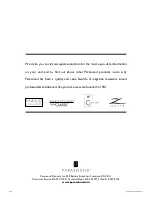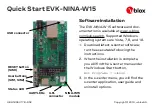
TECHNICALLY SPEAKING continued
S-Video
, uses separate wires for luminance (picture brightness – in effect, the signal portions
that make a black-and-white picture) and chrominance (color information). Keeping these picture
elements separate reduces interactions between them and produces a cleaner, more detailed
picture than composite video. It also requires the use of special connectors with four pins, two
each for the luminance and chrominance circuits. In the 7100, S-Video input signals are fed not
only to the
S-Video Output jacks
, but also to
Component Video Output jacks
.
Component Video
, which requires three cables, is capable of handling all current high-definition
television (HDTV) formats, up to 1080i (1080 lines, interlaced), and beyond. The key to the high
quality of component video is that it has three separate connections for luminance (Y), color and
color difference (Cb and Cr), rather than transmitting them mixed together and trying to separate
them in the TV set. (Not every source component or video monitor labels its component video Y,
Cb, and Cr; some may label their connections as be Y, B–Y, and R–Y or Y, Pb, and Pr. Refer to
the owner’s manual of your video component for details.) Most high quality video components,
(including large-screen TVs, video projectors, DVD players, satellite receivers) have component
video connections, and you’ll get the best possible picture quality if you use them.
Using matched Power Amplifiers:
While it’s best to use identical amplifiers for all channels, it’s sometimes more convenient or
economical to use a mixture of amps, especially if you already have some. If you do, observe
the following:
•
Check with your amplifiers’ manufacturers to see which of your amplifiers do and do not
reverse signal polarity. Then reverse the output connections of the amplifiers that reverse
polarity – and only those amps (i.e., connect their black terminals to the speakers’ red terminals,
and vice versa). This will ensure correctly matched polarity from all your speakers. Otherwise,
“imaging” (the sense of where sounds are coming from in the recorded soundfield) will be
vague, and bass may suffer.
•
It is not necessary that your amplifiers have identical input sensitivity (a measure of the input
level needed for a given output power), because any variations are automatically compensated for
when you set up and match your speaker levels.
•
Your amplifiers need not have the same power ratings, either. Low bass requires the most
amplifier power to reach adequate levels for music and special effects. So your most powerful
amplifiers should be used for your subwoofers (if they have no amplifiers of their own) and
for speakers that you identify as “Large” during 7100 setup. If you have “Large” speakers in
all channels, the front speakers should get the most power, then the surround speakers, and
the lowest-powered amps can be used for the surround back channels. If you have a mix of
“Large” and “Small” speakers, use the more powerful amps for the “Large” ones.
On-Screen Messages
The front-panel display may sometimes show these messages while you’re watching a movie:
•
“Dial Norm Offset” (Dialog Normalization Offset):
The “Dial Norm” message, which might
appear briefly on the built-in display at the beginning of a Dolby Digital DVD, shows you to what
extent the dialog level on that DVD deviates from the Dolby Labs standard level which assures
that dialog will be heard in relationship to other sounds on the disc. For example, if the dialog
offset shows +2 dB, that DVD’s dialog was recorded 2 dB too “hot.” Reducing the 7100
Controller’s volume setting by 2 dB will normalize, or restore, the relationship between the
dialog and the overall sound level.
•
“Digital Error”:
The digital bitstream being fed to the 7100 has errors in it, and the 7100 is taking
a little time to analyze it before accepting it. This may happen very briefly at the start of a DVD
or CD and for longer periods when surfing channels with a satellite receiver. While this message
appears, you won’t hear any sound; so a slight delay whenever you tune your satellite receiver to
another station is quite normal.
60













































